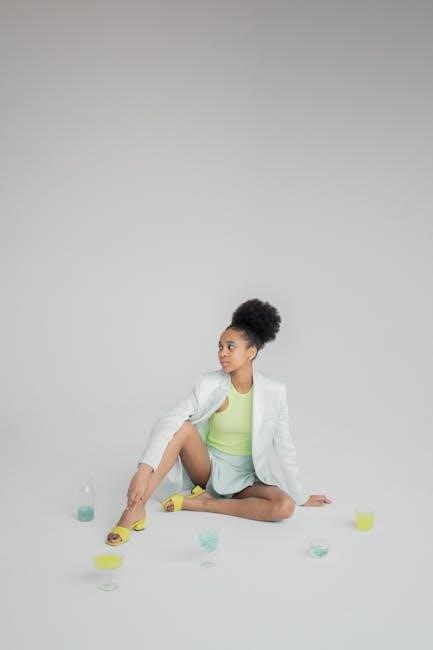Skirt length plays a crucial role in creating a balanced, flattering look. This guide helps determine the ideal skirt length based on height, body proportions, and personal style.

General Guidelines for Choosing Skirt Length
General guidelines for choosing skirt length emphasize understanding body proportions, fabric type, and footwear impact. Styling tips help balance aesthetics and comfort for a polished appearance.
2.1. Understanding Body Proportions
Body proportions are key to determining the most flattering skirt length. Petite women (under 5’3″) often benefit from shorter skirts that create balance, while taller women can pull off longer styles. The natural waistline, torso length, and leg proportions also play a significant role. For example, a shorter torso looks best with a skirt that hits just above the knee, elongating the upper body. Conversely, longer torsos can handle midi or maxi skirts without overwhelming the frame. Understanding these proportions ensures a balanced, harmonious look. Additionally, pairing skirts with fitted or chunkier tops, as suggested in fashion forums, can enhance the overall silhouette. This balance between body proportions and skirt length is essential for a polished appearance.
2.2. The Role of Fabric and Style
The choice of fabric and style significantly influences the overall appeal of a skirt. Flowy fabrics, such as chiffon or silk, create a balanced, elegant look and are ideal for taller women, as they add movement without overwhelming the frame. Structured fabrics, like wool or tweed, provide a neat silhouette and are often preferred for shorter skirts to maintain a polished appearance. The style of the skirt, whether it’s pencil, A-line, or maxi, also plays a role. A-line skirts are universally flattering, while pencil skirts are best suited for those with a defined waist. Pairing the right fabric with the skirt style ensures a harmonious look, regardless of height or body proportions. This combination helps create a balanced, stylish outfit that complements individual features. Always consider fabric drape and style to enhance your natural silhouette.
2.3. Impact of Footwear on Skirt Length
Footwear significantly influences how a skirt looks and fits. Heels can elongate the legs, making a skirt appear shorter, while flats or low heels create a more balanced proportion. For petite women, high heels paired with a midi or knee-length skirt can create a lengthening effect. Conversely, tall individuals might opt for flats to avoid overwhelming their frame. Boots, especially knee-high styles, can alter the perceived skirt length, drawing attention to the lower half of the body. Sneakers or casual shoes, on the other hand, can make a skirt appear longer due to their bulkier design. Ultimately, footwear choices should complement the skirt’s length and overall aesthetic, ensuring a harmonious balance between style and practicality. This relationship highlights the importance of considering footwear when selecting a skirt length for optimal flattering results.
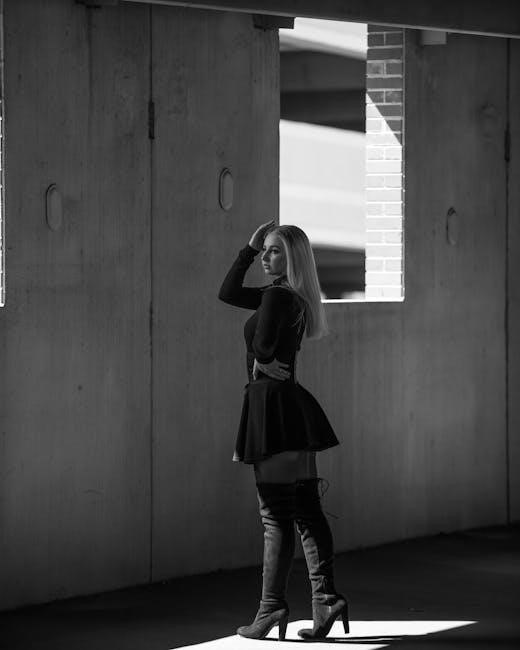
Skirt Length Guide by Height
Skirt length varies by height to ensure proportion and balance. This guide offers tailored recommendations for petite, average, and tall women to flatter their frames.
3.1. Petite Women (Under 5’3″)
For petite women, choosing the right skirt length is essential to avoid overwhelming the frame. A skirt that hits just above the knee is often ideal, as it creates a balanced proportion without making the legs appear shorter. Avoid overly voluminous fabrics, as they can add bulk. Instead, opt for tailored or pencil skirts that skim the body. A-line skirts can also work well, as they create a flattering silhouette. Pairing the skirt with heels or pointed-toe shoes can elongate the legs further. Avoid skirts that are too long, as they may make the torso appear shorter. The key is to find a length that complements the body’s natural proportions while maintaining a polished, put-together look.
3.2. Average Height Women (5’3″-5’7″)
For women of average height (5’3″-5’7″), midi skirts are often the most flattering choice, as they create a balanced proportion. A skirt that falls just above the knee or mid-calf length elongates the legs without overwhelming the frame. Pairing a fitted top or a tailored jacket with a midi skirt enhances the silhouette. For a casual look, a knee-length skirt with a relaxed fit works well, especially when paired with flats or ankle boots. Heeled footwear can add height and sophistication, making the outfit versatile for both daytime and evening events. Ensuring the skirt hits just above the knee prevents it from appearing too short or overly modest, striking the perfect balance for a polished, confident appearance.
3.3. Tall Women (Over 5’7″)
Tall women have the advantage of pulling off a wide range of skirt lengths due to their naturally elongated silhouette. Midi skirts, which fall just above the calf, create a balanced, proportional look. Maxi skirts can also be flattering, as they elongate the legs further, especially when paired with heeled footwear. For a more modern vibe, tall women can opt for shorter skirts, such as just above the knee, to emphasize their height without overwhelming their frame. When styling, it’s important to balance the volume of the skirt with a fitted top or a cropped jacket to maintain a cohesive, polished appearance. Additionally, footwear plays a key role; low heels or flats can enhance the overall elongation of the legs, making tall women appear even more statuesque.

Body Proportions and Skirt Length
Body proportions significantly influence skirt length choices. Understanding torso, waist, and hip ratios helps create a balanced, flattering fit. Measurements guide selecting styles that complement your silhouette.
4.1. Torso Length Considerations
Torso length significantly impacts how a skirt fits and flatters the body. Women with longer torsos may find that skirts hit them lower, creating a balanced proportion with their legs. Conversely, those with shorter torsos should opt for skirts that don’t overwhelm their frame. Pairing skirts with tops that cinch at the waist or tuck in can help elongate the torso. For a professional look, ensure the skirt sits comfortably at the natural waistline. When measuring, consider the distance from the waist to the desired hemline to ensure harmony with your body’s proportions. This balance ensures a flattering silhouette, regardless of personal style or occasion.
4.2. Waist and Hip Ratio
The waist-to-hip ratio significantly impacts skirt length choices. For women with a longer torso, skirts that hit just above the hip can create balance, while those with a shorter torso may prefer skirts that fall below the hip. A defined waistline can be emphasized with a skirt that cinches at the natural waist, creating a flattering silhouette. Conversely, a flowy skirt can balance broader hips, drawing attention away from the waist. Ensuring the skirt complements the natural curves enhances overall proportions, making the outfit more visually appealing and tailored to individual body types.
4.3. Leg Length and Skirt Hem
Leg length significantly influences skirt hem choices. Women with longer legs can opt for shorter hems to accentuate their legs, while those with shorter legs may prefer longer hems for a more proportional look. The hem should align with overall height and body proportions; Petite women often find hems just above the knee elongate their legs, whereas taller women can explore diverse hemlines. Footwear, such as high heels, can complement the chosen skirt length, enhancing the silhouette. Tailored hems and appropriate fabrics also play a role in achieving a balanced, polished appearance suitable for various occasions, ensuring both comfort and style.
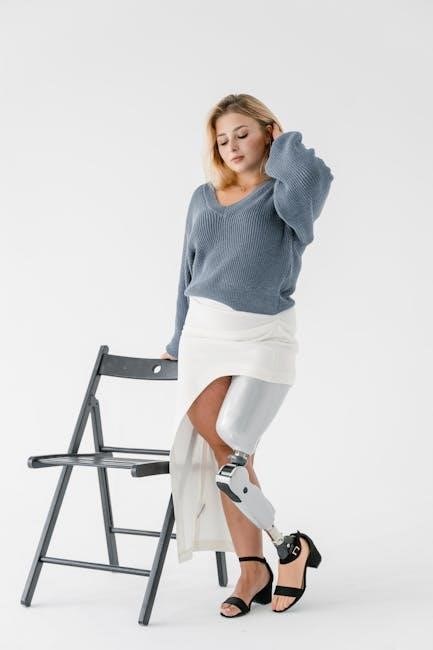
Fabric and Skirt Style Recommendations
Fabric and style significantly impact skirt length choices. Flowy fabrics balance proportions, while structured styles create clean lines. Patterns and textures add visual interest to various skirt lengths.
5.1. Flowy Fabrics for Balance
Flowy fabrics, such as chiffon, georgette, or lightweight cotton, create a balanced silhouette by adding movement and softness to the skirt. These fabrics are ideal for achieving a relaxed, effortless look while complementing various body types. For petite women, flowy skirts can create the illusion of longer legs when paired with structured tops or heels. Taller individuals can opt for floor-sweeping or midi flowy skirts to elongate their frame. The fluid drape of these fabrics skims over the body, hiding any areas of concern while enhancing natural curves. They are versatile for both casual and semi-formal occasions, making them a great choice for everyday wear or special events. Styling tips include pairing with fitted tops or belts to define the waistline, ensuring a polished yet comfortable outfit.
5.2. Structured Fabrics for Neat Silhouettes
Structured fabrics, such as wool, tweed, or gabardine, create a polished, defined shape that enhances any skirt length. These fabrics hold their form, providing a clean line from waist to hem, which is especially flattering for those seeking a professional or elegant look. For petite women, structured skirts in knee-length or midi styles can elongate the legs, while taller individuals can opt for longer lengths without overwhelming their frame. Pairing structured fabrics with tailored tops or blazers creates a balanced, put-together appearance. Additionally, belts or statement accessories can further define the waist, ensuring a streamlined silhouette. This style is ideal for formal events or workplace settings, offering both sophistication and versatility.
5.3. Patterns and Textures
Patterns and textures can greatly enhance your skirt’s aesthetic while complementing your height and body proportions. Vertical stripes or diagonal patterns can create a lengthening effect, ideal for petite frames, while bold textures like suede or lace add depth without overwhelming shorter silhouettes. For taller women, intricate patterns or statement textures can balance proportions, avoiding a overly elongated look. Conversely, minimal patterns like subtle florals or soft tweeds work well for average heights, offering versatility. Mixing patterns with textures, such as pairing a striped top with a textured skirt, can create a balanced outfit. Ultimately, the choice of pattern and texture should align with personal style and the occasion, ensuring a flattering and cohesive look. This approach allows for endless creativity while maintaining a polished appearance.
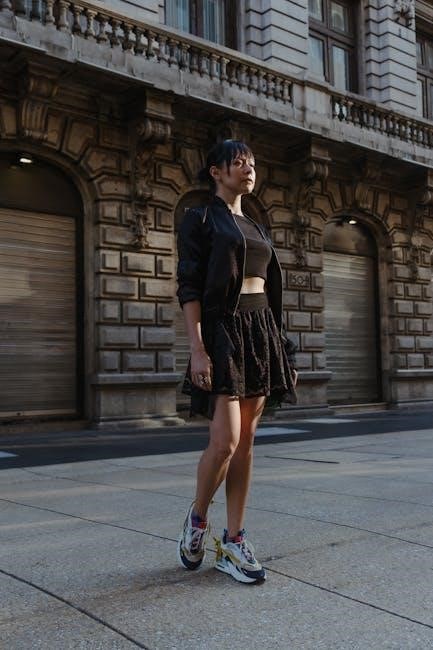
Skirt Length for Different Occasions
Skirt length varies by occasion. For workplaces, knee-length or midi skirts are ideal. Formal events call for floor-sweeping or tea-length styles. Casual outings allow mini or maxi options.
6.1. Workplace Appropriate Lengths
When it comes to workplace attire, skirt length is a key factor in maintaining professionalism. Generally, skirts should fall no shorter than two inches above the knee. For petite women, a skirt that hits just above the knee creates a balanced look, while taller individuals can opt for slightly shorter lengths without compromising modesty. Avoid overly tight or clingy fabrics, as they may appear inappropriate. Structured fabrics like wool or pencil skirts are ideal for a polished appearance. Pairing the skirt with tailored blazers or fitted tops enhances the professional aesthetic. Ensure the skirt isn’t too tight around the hips to maintain comfort and a neat silhouette. These guidelines help in selecting a skirt that aligns with workplace norms while flattering your height and body proportions.
6.2. Formal Events and Evening Wear
For formal events and evening wear, skirt length often emphasizes elegance and sophistication. Floor-sweeping or midi skirts are ideal, as they create a dramatic, polished look. These lengths complement most heights, with taller women effortlessly pulling off longer skirts, while midi skirts offer a universally flattering option. Luxurious fabrics like satin, silk, or velvet enhance the formal appeal. Pairing a fitted top or a tailored jacket with a full skirt adds balance and sophistication. For shorter women, a high slit or subtle detailing can create the illusion of length. While shorter skirts, like mini styles, can be stylish, they may not be suitable for all formal settings. Opting for a skirt that hits just above the knee ensures a chic yet respectful appearance. Accessories, such as statement jewelry or heels, further elevate the ensemble for a cohesive, glamorous look.
6.3. Casual and Everyday Looks
For casual outings, midi and maxi skirts are versatile choices, offering comfort and style. Knee-length skirts are ideal for most body types, creating a balanced silhouette. Petite women can opt for skirts just above the knee to elongate legs, while taller individuals can embrace longer lengths for a relaxed look. Pairing skirts with graphic tees, sneakers, or flats enhances the casual vibe. Adding a denim jacket or cardigan can effortlessly layer the outfit. Accessories like crossbody bags or layered necklaces keep the look modern yet understated. Footwear plays a key role; sneakers or loafers are perfect for a laid-back appearance, while ankle boots add a chic touch. This approach ensures a stylish, comfortable ensemble for everyday wear.
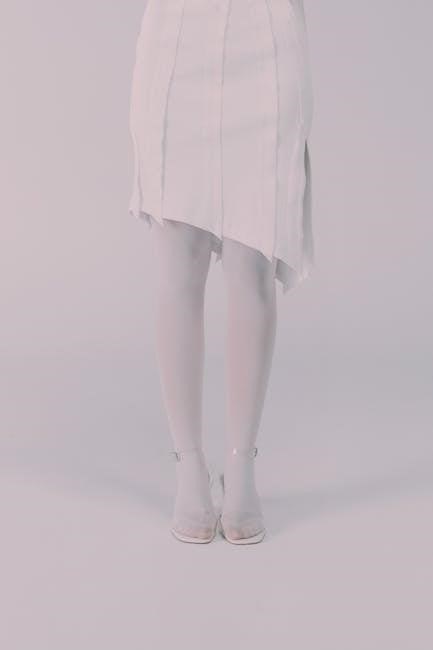
Styling Tips to Flatter Your Figure
Balanced proportions, enhancing curves, and creating a polished look are key. Use tailored tops, belts, and heels to elongate the silhouette for a flattering, cohesive ensemble.
7.1. Pairing with Tops and Jackets
Pairing your skirt with the right top or jacket can enhance your overall look. For petite women, opt for fitted tops or cropped jackets to elongate the torso. Average-height individuals can balance flowy skirts with tailored tops or structured jackets. Taller women can experiment with loose-fit tops or longer jackets for a balanced silhouette. Styling tips include tucking tops into skirts for a defined waist or layering jackets to add texture. Accessories like belts can cinch the waist, creating a flattering contrast with the skirt. Consider V-necks or A-line jackets to draw the eye upward, complementing the skirt length. These combinations ensure a polished, proportional look tailored to your height and body type.
7.2. Accessories and Belts
Accessories and belts can enhance your skirt look while complementing your height. For petite women, delicate belts or waist-cinching styles create balance without overwhelming the frame. Tall individuals can opt for wider belts to break up the torso. Statement jewelry draws attention upward, elongating the silhouette for shorter women, while simpler designs keep the focus on the skirt for taller frames. Footwear choices, like heels or flats, also influence how accessories are perceived. Layering necklaces or scarves can add depth, but ensure they don’t clash with the skirt’s pattern or texture. Belts in contrasting colors or textures add definition, especially for flowy skirts. Pairing accessories thoughtfully ensures a cohesive, polished outfit that flatters your figure and height. Experiment to find the perfect balance for your unique style.
7.3. Footwear Choices
Footwear plays a significant role in balancing the overall look when paired with skirts. High heels can elongate the legs, making them appear longer, which is particularly flattering with shorter skirts. Flats, on the other hand, create a more relaxed, casual vibe and work well with midi or maxi skirts. Ankle boots are versatile and complement both short and long skirts, adding a stylish touch. Knee-high boots pair nicely with longer skirts, creating a balanced silhouette. When choosing footwear, consider the skirt’s length and the desired formality of the outfit. For example, heels can elevate a short skirt for a professional setting, while sneakers can casualize a midi skirt for everyday wear. Ultimately, the right footwear enhances both comfort and style, ensuring a harmonious look with your chosen skirt length.
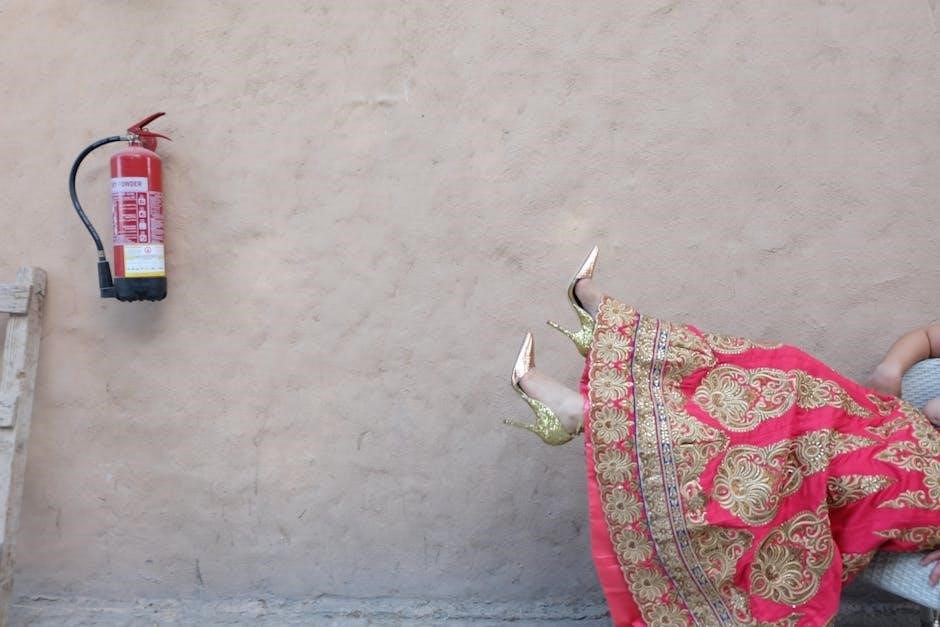
How to Measure for the Perfect Fit
Lay the skirt flat, smooth wrinkles, and measure from the natural waist to the desired hem length using a flexible tape measure for accuracy.
8.1. Measuring Waist and Hips
To ensure the perfect fit, accurately measure your waist and hips. For the waist, locate your natural waistline, typically just above the belly button. Use a flexible tape measure, wrapping it snugly but not too tight. Ensure the tape is level and parallel to the floor. For the hips, measure around the widest part, usually 7-9 inches below the waistline. Stand upright and relax your stance to get precise measurements. These measurements are crucial for determining skirt sizing and ensuring a flattering fit. Double-check the measurements to avoid any discrepancies, as accurate numbers are essential for tailoring or selecting ready-made skirts.
8.2. Determining Skirt Length
Determining the perfect skirt length involves balancing personal style with flattering proportions. Start by laying the skirt flat, smoothing out wrinkles, and measuring from the waistband to the hem. For accuracy, ensure the skirt is buttoned or zipped. Consider your height, body proportions, and the occasion; Petite women may prefer shorter hemlines to elongate legs, while taller individuals can pull off longer styles. Use online sizing charts as a reference, but always measure the skirt on your body for the best fit. Avoid over-measuring, as this can lead to inaccuracies. Pair the skirt with footwear to assess how the length complements your overall look. Remember, the right length enhances confidence and creates a polished appearance.
8.3. Sizing Charts and Adjustments
Consulting sizing charts is essential for ensuring a perfect fit. Measure your waist and hips accurately, as these are critical for skirt sizing. Lay the skirt flat to measure length and compare it to your body proportions. Adjustments may be needed for petite, average, or tall frames. For example, tall women might opt for longer skirts, while petites may prefer shorter hems. Fabric stretch and style also influence fit. Double-check measurements and consider alterations if necessary. Use online guides or sizing tools for precise calculations. Proper fit enhances comfort and confidence, making sizing charts a valuable resource in choosing the ideal skirt length for your height and body type.
Choosing the right skirt length can elevate your style and confidence. By considering height, body proportions, fabric, and occasion, you can find a skirt that flatters your figure. Whether petite, average, or tall, the right length enhances balance and creates a polished look. Experiment with styles and pairings to discover what works best for you, ensuring your wardrobe reflects both comfort and chic. Remember, skirt length is a personal choice, so embrace what makes you feel confident and expressive. With these guidelines, you’re ready to select skirts that complement your unique silhouette and lifestyle, ensuring timeless elegance in every outfit.
